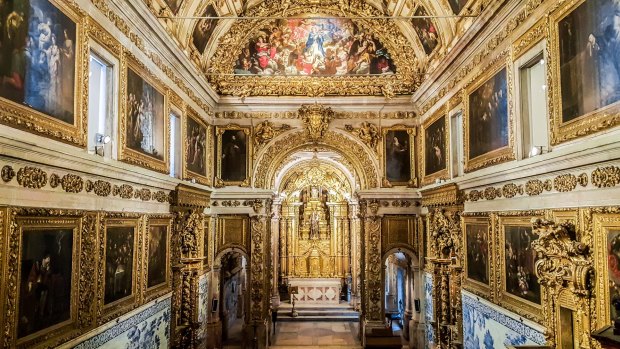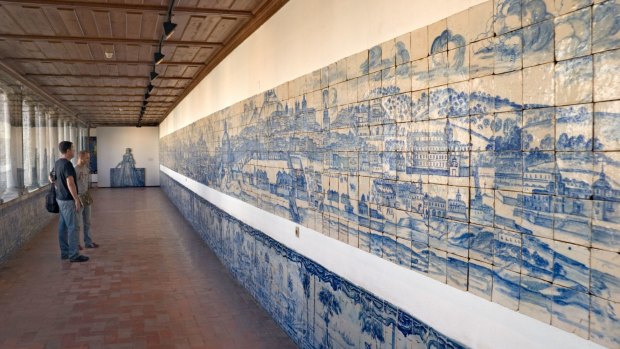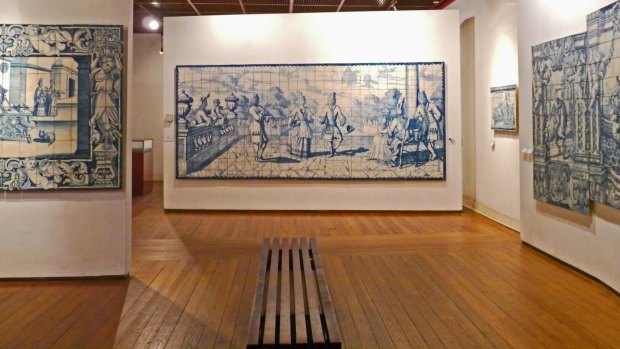This was published 4 years ago
National Tile Museum, Lisbon: Where to see Portugal's famous azulejos (title art)
By Libby Moffet

The Mother of God Church (Madre de Deus Church) in Tile National Museum (Azulejo National Museum).Credit: Shutterstock
If there was only one word to describe Lisbon, that word would be "shimmering". But it's not the warm European sun that gives the Portuguese capital its glow during our autumn visit, nor the endless sparkle of its vast natural harbour.
Rather, it is the city itself shimmering as the light dances on the colourful tiles that cover so many of its buildings. First brought to Portugal from Spain in the 15th century, these decorative tiles, known as azulejos, have become a proud feature of the nation's heritage, adorning the walls of churches, shops, hotels, houses and even train stations throughout the country.
While Lisbon's azulejos can be easily admired as you take in the city sights, a trip to the National Tile Museum, Museu Nacional do Azulejo, provides a wonderful insight into the rich history of Portugal and turns up some extraordinary national treasures. Housed in a former convent, the unassuming museum sits beside a railway line several kilometres from Lisbon's old centre. Spread over three floors encasing a cloistered garden, the museum takes visitors on a journey through 500 years of colourful exhibits, with a downloadable audio guide providing an excellent commentary.

Early 18th century azulejo on display at the National Tile Museum. Credit: Alamy
While many assume that the word "azulejo" stems from the blue and white hues of early tiles, given "azul" is Portuguese for blue, museum visitors soon learn it is derived from the Arab word for polished stone, "al-zulaich". The museum's first floor houses Portugal's oldest azulejo, produced more than 500 years ago for the floor of Leiria Castle, north of Lisbon, as well as an azulejo masterpiece, the Our Lady of Life panel, created in 1580. Made from almost 1500 tiles and standing five metres tall, this exquisite panel resembles a religious painting, with a mid-16th century breakthrough in the tile-making process delivering a range of colours rarely seen at the time.
Nearby is one of the museum's true treasures, the convent's lavishly decorated Church of the Convento de Madre Deus. An outstanding example of Portuguese baroque design, the church is covered in pictures made from beautiful azulejos, as well as gilded carvings and paintings, with no surface left bare. Despite the intense detail, the space was designed to create a sense of harmony and many visitors linger on the wooden pews in quiet contemplation.
The museum's second floor yields other delights. The ornate St Antonio Chapel provides a balanced collection of baroque gold gilded carvings and blue azulejos, providing insight into the Portuguese saying "ouro sobre azul", or "gold over blue", meaning something is perfect.

Inside the National Tile Museum, Lisbon, Portugal.Credit: Alamy
After an earthquake devastated much of Lisbon in 1755, tile-making took on a new life and the azulejos patterns of the period were dubbed pombaline, in reference to the Portuguese statesman who rebuilt the city, the Marquis of Pombal. The museum houses a fine collection of these colourful patterns, which can still be found in the shops and houses in Lisbon's downtown Baixa area, as well as the religious panels created to provide divine protection against future catastrophes.
Modern Portugal is home to old and new tiles and the museum's top floor reveals some wonderful 20th-century tile creations that have established a new form of urban art, visible in many of Lisbon's metro stations. But the real attraction on this level is the Lisbon View Panel, a masterpiece made from more than 1300 tiles. Created before the 1755 earthquake, the massive blue and white panel depicts a 14-kilometre stretch of the city in great detail, providing a rare look at Lisbon before the tragedy.
As a piece of art it is beautiful, but as a piece of history it is astounding, and a wonderful final reminder of the role that azulejos have played in portraying the rich tapestry of Portuguese life.
TRIP NOTES
Libby Moffet travelled at her own expense.
MORE
FLY
Singapore Airlines operates numerous flights a week to Singapore from Sydney and Melbourne, with five flights a week connecting to Barcelona. TAP Air Portugal flies between Lisbon and Barcelona. See singaporeair.com ; flytap.com
STAY
Hotel da Baixa is a 66-room hotel in Lisbon's Baixa district, near many of the city's attractions. Rooms from around €100. See hoteldabaixa.com
VISIT
Museu Nacional do Azulejo (National Tile Museum) is open Tuesday to Sunday. Entry is €5. See museudoazulejo.gov.pt
Sign up for the Traveller Deals newsletter
Get exclusive travel deals delivered straight to your inbox. Sign up now.